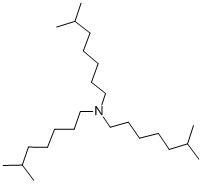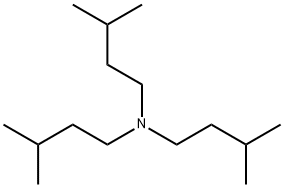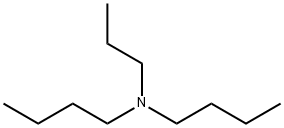Triisooctylamine
Synonym(s):Triisooctylamine
- CAS NO.:25549-16-0
- Empirical Formula: C24H51N
- Molecular Weight: 353.67
- MDL number: MFCD00011694
- EINECS: 247-092-0
- SAFETY DATA SHEET (SDS)
- Update Date: 2025-01-27 09:38:02

What is Triisooctylamine ?
The Uses of Triisooctylamine
TRIISOOCTYLAMINE has been used in: Determination of uranium isotopes in various environmental samples by liquid-liquid extraction and α spectrometry;Extraction of uranium from sulphuric acid leaches of uranium-bearing ores; Extraction of Pd(II), Rh(III), Ir(III), Au(III) and Pt(IV) from hydrochloric and hydrobromic acid.
The Uses of Triisooctylamine
Triisooctylamine has been used in:
- determination of uranium isotopes in various environmental samples by liquid-liquid extraction and α spectrometry
- extraction of uranium from sulphuric acid leaches of uranium-bearing ores
- extraction of Pd(II), Rh(III), Ir(III), Au(III) and Pt(IV) from hydrochloric and hydrobromic acid
What are the applications of Application
Triisooctylamine is used in a variety of scientific and industrial applications. It is used as a surfactant and emulsifier in the production of detergents and cosmetics, and as a corrosion inhibitor in the production of paints and coatings. It is also used as a lubricant in the manufacture of plastics and rubber. In addition, triisooctylamine is used in the pharmaceutical industry as a solubilizing agent for drugs and as a stabilizing agent for proteins.
Flammability and Explosibility
Not classified
Properties of Triisooctylamine
| Density | 0.816 g/mL at 25 °C (lit.) |
| vapor density | >1 (vs air) |
| vapor pressure | 0.001Pa at 20℃ |
| refractive index | n |
| Flash point: | >230 °F |
| storage temp. | Store below +30°C. |
| solubility | <1g/l |
| Boiling point: | >204°C |
| InChI | InChI=1S/C24H51N/c1-22(2)16-10-7-13-19-25(20-14-8-11-17-23(3)4)21-15-9-12-18-24(5)6/h22-24H,7-21H2,1-6H3 |
| CAS DataBase Reference | 25549-16-0(CAS DataBase Reference) |
| EPA Substance Registry System | Isooctanamine, N,N-diisooctyl- (25549-16-0) |
Safety information for Triisooctylamine
| Signal word | Warning |
| Pictogram(s) |
 Exclamation Mark Irritant GHS07  Environment GHS09 |
| GHS Hazard Statements |
H302:Acute toxicity,oral H315:Skin corrosion/irritation H319:Serious eye damage/eye irritation H335:Specific target organ toxicity, single exposure;Respiratory tract irritation H411:Hazardous to the aquatic environment, long-term hazard |
| Precautionary Statement Codes |
P261:Avoid breathing dust/fume/gas/mist/vapours/spray. P264:Wash hands thoroughly after handling. P264:Wash skin thouroughly after handling. P273:Avoid release to the environment. P301+P312:IF SWALLOWED: call a POISON CENTER or doctor/physician IF you feel unwell. P302+P352:IF ON SKIN: wash with plenty of soap and water. P305+P351+P338:IF IN EYES: Rinse cautiously with water for several minutes. Remove contact lenses, if present and easy to do. Continuerinsing. |
Computed Descriptors for Triisooctylamine
| InChIKey | YKGBNAGNNUEZQC-UHFFFAOYSA-N |
| SMILES | N(CCCCCC(C)C)(CCCCCC(C)C)CCCCCC(C)C |
New Products
Methyl (R)-1-Boc-4,4-difluoropyrrolidine-2-carboxylate 2,2-Difluoropropylamine hydrochloride tert-butyl 3-bromoazetidine-1-carboxylate (R)-1-Boc-3-hydroxypyrrolidine DIFLUOROACETIC ANHYDRIDE 2,2-Difluoropropionic acid Diallylamine, 99% Calcium hydroxide, 95% Aluminum oxide, basic 2-Bromophenylacetonitrile, 97% L-tert-Leucine,97% N-Hydroxy-2-methylpropanimidamide 4-(3,4-Dichlorophenyl)-3,4-Dihydro-N-Methyl-1-(2H)-Naphthalenimine (Schiff Base) 2-AMINO-3,5-DIBROMO BENZALDEHYDE [ADBA] L-Glutamic Acid Dimethyl Ester Hcl 10-Methoxy-5H-dibenz[b,f]azepine 5-Cyanophthalide N, N-Carbonyldiimidazole (CDI) Dibenzoyl Peroxide Titanium Dioxide 2-(Methylthio) Benzonitrile Sodium Acetate Anhydrous Allopurinol 1,5-DibromopentaneRelated products of tetrahydrofuran








You may like
-
 Triisooctylamine CAS 25549-16-0View Details
Triisooctylamine CAS 25549-16-0View Details
25549-16-0 -
![Cis-2-(Bromomethyl)-2-(2,4-Dichlorophenyl)-1,3-Dioxolane-4-Ylmethyl Benzoate [CBB] 61397-56-6 99%](https://img.chemicalbook.in//Content/image/CP5.jpg) Cis-2-(Bromomethyl)-2-(2,4-Dichlorophenyl)-1,3-Dioxolane-4-Ylmethyl Benzoate [CBB] 61397-56-6 99%View Details
Cis-2-(Bromomethyl)-2-(2,4-Dichlorophenyl)-1,3-Dioxolane-4-Ylmethyl Benzoate [CBB] 61397-56-6 99%View Details
61397-56-6 -
 287930-77-2 / 142569-70-8 99%View Details
287930-77-2 / 142569-70-8 99%View Details
287930-77-2 / 142569-70-8 -
 Ethyl-2-Chloroacetoacetate 609-15-4View Details
Ethyl-2-Chloroacetoacetate 609-15-4View Details
609-15-4 -
 CIS- BROMO BENZOATEView Details
CIS- BROMO BENZOATEView Details
61397-56-6 -
 609-15-4View Details
609-15-4View Details
609-15-4 -
![1-(6-Methylpyridin-3-Yl)-2-[4-(Methylsulfonyl)Phenyl]Ethanone [Ketosulfone] 99%](https://img.chemicalbook.in//Content/image/CP5.jpg) 1-(6-Methylpyridin-3-Yl)-2-[4-(Methylsulfonyl)Phenyl]Ethanone [Ketosulfone] 99%View Details
1-(6-Methylpyridin-3-Yl)-2-[4-(Methylsulfonyl)Phenyl]Ethanone [Ketosulfone] 99%View Details
221615-75-4 -
 27143-07-3View Details
27143-07-3View Details
27143-07-3
